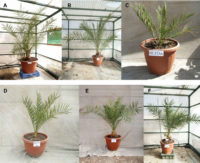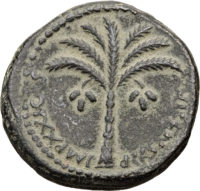 It feels like just yesterday when I wrote about Methuselah, the date palm germinated from a 2,000-year-old seed recovered from Masada, but it was 12 years ago. This must be the longest stretch between an original story and an update yet. It is occasioned by a new study of six ancient date palm seeds that have been successfully germinated. Now Adam, Jonah, Uriel, Boaz, Judith and Hannah have joined their ancient brother in growing from seed to seedling.
It feels like just yesterday when I wrote about Methuselah, the date palm germinated from a 2,000-year-old seed recovered from Masada, but it was 12 years ago. This must be the longest stretch between an original story and an update yet. It is occasioned by a new study of six ancient date palm seeds that have been successfully germinated. Now Adam, Jonah, Uriel, Boaz, Judith and Hannah have joined their ancient brother in growing from seed to seedling.
The six well-preserved seeds were discovered in archaeological excavations of Masada (Adam), Qumran (Jonah, Uriel, Boaz, Judith) and Wadi Makukh (Hannah) from the 1960s through the 1990s. The ages of the seeds were determined by radiocarbon dating of the shell fragments collected from the roots when the plants were repotted. Methuselah, his Masada brother Adam and Hannah are the oldest, dating to between the 4th and 1st century B.C. Judith and Boaz are the middle kids, dating to the mid-2nd century B.C. to the mid-1st century A.D. Uriel and Jonah are the babies of the family dating to the 1st-2nd century A.D.
The team was able to use DNA analysis to discover the sex of the germinated seedlings and to map out the geographic origin of their genotypes. (Methuselah is indeed a male plant, by the way. We didn’t know if there was a chance of getting an ancient date when it was first germinated, but now we do. He’s a pollen producer, not a fruiter.)  Interestingly, the age of the seeds correlates with their genetic admixture. The oldest three have the most eastern genotypes. Judith and Boaz have equal western and eastern genotypes. Jonah and Uriel have the most western. The large size of the seeds is evidence that they were domesticated (wild seeds are much smaller) and the genetic analysis indicates extensive cross-breeding of females with foreign males to keep the stock vigorous and varied.
Interestingly, the age of the seeds correlates with their genetic admixture. The oldest three have the most eastern genotypes. Judith and Boaz have equal western and eastern genotypes. Jonah and Uriel have the most western. The large size of the seeds is evidence that they were domesticated (wild seeds are much smaller) and the genetic analysis indicates extensive cross-breeding of females with foreign males to keep the stock vigorous and varied.
Date palms have been cultivated in the Jordan River Valley since the Neolithic and the wild date is widespread on the banks of the river and in the hills around the Dead Sea. Palm trees, leaves and dates appear often in the Hebrew scripture — waved in the Sukkot holiday, to celebrate military victories, used in temple rituals, decorating palaces and sacred buildings, even in place names — and their significance was transmitted to Christian tradition, viz Palm Sunday. Ancient writers from Herodotus to Hippocrates praised the Judean date for culinary and medicinal qualities. It was semi-dry and therefore easily stored long-term, unlike Egyptian or Cypriot varieties that rotted quickly. Theophrastus (c. 371- 287 B.C.) wrote in his botanical treatise Enquiry into Plants:
It likes a soil which contains salt; wherefore, where such soil is not available, the growers sprinkle salt about it; and this must not be done about the actual roots: one must keep the salt some way off and sprinkle about a gallon. To shew that it seeks such a soil they offer the following proof; wherever date-palms grow abundantly, the soil is salt, both in Babylon, they say, where the tree is indigenous, in Libya in Egypt and in Phoenicia; while in Coele-Syria [modern-day Israel], where are most palms, only in three districts, they say, where the soil is salt, are dates produced which can be stored; those that grow in other districts do not keep, but rot, though when fresh they are sweet and men use them at that stage.
The Judean date’s long storage properties made them ideal emergency rations. Josephus mentions them “heaps” of dates at the fortress of Masada.  The date palm was so strongly associated with Judea that it was frequently depicted on ancient shekels and, after Titus’ sack of Jerusalem in 70 A.D., on Roman IUDAEA CAPTA coinage for more than twenty years. The date palm still features prominently on coins and medallions issued by the modern state of Israel.
The date palm was so strongly associated with Judea that it was frequently depicted on ancient shekels and, after Titus’ sack of Jerusalem in 70 A.D., on Roman IUDAEA CAPTA coinage for more than twenty years. The date palm still features prominently on coins and medallions issued by the modern state of Israel.
The research team is hoping to pick up where ancient farmers left off and do some pollinating of their own once Judith and Hannah reach sexual maturity. If, fingers crossed, they’re able to produce Judean dates once again, of course we’ll have no way of knowing if they have the same taste and texture.